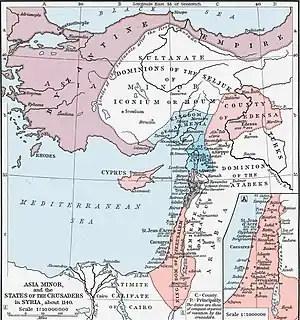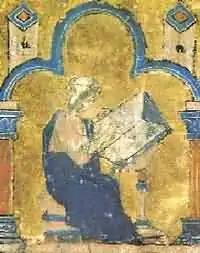The Middle Ages portal
.jpg.webp)
In the history of Europe, the Middle Ages or medieval period (also spelled mediæval or mediaeval) lasted approximately from 500 AD to 1500, although alternative starting and end points exist. The Middle Ages is the middle period of the three traditional divisions of Western history: antiquity, medieval, and modern. The medieval period is itself subdivided into the Early, High, and Late Middle Ages, and the early medieval period is alternatively referred to as the Dark Ages.
Population decline, counterurbanisation, the collapse of centralised authority, invasion and the mass migration of tribes, which had begun in late antiquity, continued into the Early Middle Ages. The large-scale movements of the Migration Period, including of Germanic peoples, led to the rise of new kingdoms in Western Europe. In the 7th century, the Middle East and North Africa came under caliphal rule with the Arab conquests. The Byzantine Empire survived in the Eastern Mediterranean and advanced secular law through the Code of Justinian. In the West, most kingdoms incorporated extant Roman institutions, while the influence of Christianity expanded across Europe. The Carolingian dynasty of the Franks established the Carolingian Empire during the later 8th and early 9th centuries in Western Europe before it succumbed to internal conflict and external invasions.
During the High Middle Ages, which began after 1000, the population of Europe increased greatly as technological and agricultural innovations allowed trade to flourish and the Medieval Warm Period climate change allowed crop yields to increase. Manorialism, the organisation of peasants into villages that owed rent and labour services to the nobles, and feudalism, the political structure whereby knights and lower-status nobles owed military service to their overlords in return for the right to rent from lands and manors, were two of the ways society was organised in the High Middle Ages. This period also saw the formal division of the Catholic and Orthodox churches, with the East–West Schism of 1054. The Crusades, which began in 1095, were military attempts by Western European Christians to regain control of the Holy Land from Muslims and also contributed to the expansion of Latin Christendom in the Baltic region and the Iberian Peninsula. In the West, intellectual life was marked by scholasticism, a philosophy that emphasised joining faith to reason, and by the founding of universities. The theology of Thomas Aquinas, the paintings of Giotto, the poetry of Dante and Chaucer, the travels of Marco Polo, and the Gothic architecture of cathedrals such as Chartres mark the end of this period.
The Late Middle Ages was marked by difficulties and calamities including famine, plague, and war, which significantly diminished the population of Europe; between 1347 and 1350, the Black Death killed about a third of Europeans. Controversy, heresy, and the Western Schism within the Catholic Church paralleled the interstate conflict, civil strife, and peasant revolts that occurred in the kingdoms. Cultural and technological developments transformed European society, concluding the Late Middle Ages and beginning the early modern period. (Full article...)
Selected article

Selected biography

William of Tyre (c. 1130 – 29 September 1186) was a medieval prelate and chronicler. As archbishop of Tyre, he is sometimes known as William II to distinguish him from a predecessor, William of Malines. He grew up in Jerusalem at the height of the Kingdom of Jerusalem, which had been established in 1099 after the First Crusade, and he spent twenty years studying the liberal arts and canon law in the universities of Europe.
Following William's return to Jerusalem in 1165, King Amalric I made him an ambassador to the Byzantine Empire. William became tutor to the king's son, the future King Baldwin IV, whom William discovered to be a leper. After Amalric's death, William became chancellor and archbishop of Tyre, two of the highest offices in the kingdom, and in 1179 William led the eastern delegation to the Third Council of the Lateran. As he was involved in the dynastic struggle that developed during Baldwin IV's reign, his importance waned when a rival faction gained control of royal affairs. He was passed over for the prestigious Patriarchate of Jerusalem, and died in obscurity, probably in 1186.
William wrote an account of the Lateran Council and a history of the Islamic states from the time of Muhammad. Neither work survives. He is famous today as the author of a history of the Kingdom of Jerusalem. William composed his chronicle in excellent Latin for his time, with numerous quotations from classical literature. The chronicle is sometimes given the title Historia rerum in partibus transmarinis gestarum ("History of Deeds Done Beyond the Sea") or Historia Ierosolimitana ("History of Jerusalem"), or the Historia for short. It was translated into French soon after his death, and thereafter into numerous other languages. Because it is the only source for the history of twelfth-century Jerusalem written by a native, historians have often assumed that William's statements could be taken at face value. However, more recent historians have shown that William's involvement in the kingdom's political disputes resulted in detectable biases in his account. Despite this, he is considered the greatest chronicler of the crusades, and one of the best authors of the Middle Ages. (Read more...)
Did you know...
- ...that a paillasse is a thin mattress filled with hay or sawdust and was commonly used in the middle ages?
- ...that a barbican is a tower or other fortification defending the drawbridge, usually the gateway?
- ...that a coif is a type of armored head-covering made out of chain-mail and worn under the helmet for extra protection?
- ...that a heriot is a payment owed to the lord of the manor by a serf’s family upon the serf’s death; usually the family’s best animal, such as a cow, horse or most commonly ox?
- ...that before 1066, it was noted in the Domesday Book, if one Welshman killed another, the dead man’s relatives could exact retribution on the killer and his family (even burning their houses) until burial of the victim the next day?
- ...that buboes are pus-filled egg-sized swellings of the lymph glands of the neck, armpits, and groin; typically found in cases of bubonic plague?
- ...that laws passed in the late 1300s aimed at maintaining class distinctions by prohibiting lower classes from dressing as if they belonged to higher classes?
- ...that Pier Gerlofs Donia, a 15th century Frisian freedom fighter of 7 feet tall was alleged to be so strong that he could lift a 1000 pound horse?
- ...that Edgar Ætheling was the last of the Anglo-Saxon Kings of England, but was only proclaimed, never crowned?
Selected image
 Double-headed eagle of the Holy Roman Empire, by Hans Burgkmair. |
The double-headed eagle is a common symbol in heraldry and vexillology. It is most commonly associated with the Byzantine Empire, the Holy Roman Empire, the Russian Empire and their successor states. Hans Burgkmair the elder was a German painter and woodcut printmaker.
Related portals
Subcategories
Topics
Medieval Armenia · History of Bosnia and Herzegovina (958–1463) · Bulgarian Empire · Britain in the Middle Ages · Byzantine Empire · Medieval Croatian state · Crusader states · History of the Czech lands in the Middle Ages · England in the Middle Ages · France in the Middle Ages · Germany in the Middle Ages · Italy in the Middle Ages · Kievan Rus′ · Poland in the Middle Ages · Portugal in the Middle Ages ·Romania in the Middle Ages · Scotland in the High Middle Ages · History of Medieval Serbia · Spain in the Middle Ages · Women in the Middle Ages · Kingdom of Hungary in the Middle Ages · Wales in the Middle Ages
Things you can do
 |
Here are some tasks awaiting attention:
|
WikiProjects
- WikiProject History
- Middle Ages WikiProject
- WikiProject Medieval Scotland
- WikiProject Military history/Medieval warfare task force
- WikiProject King Arthur
Associated Wikimedia
The following Wikimedia Foundation sister projects provide more on this subject:
-
 Commons
Commons
Free media repository -
 Wikibooks
Wikibooks
Free textbooks and manuals -
 Wikidata
Wikidata
Free knowledge base -
 Wikinews
Wikinews
Free-content news -
 Wikiquote
Wikiquote
Collection of quotations -
 Wikisource
Wikisource
Free-content library -
 Wikiversity
Wikiversity
Free learning tools -
 Wiktionary
Wiktionary
Dictionary and thesaurus